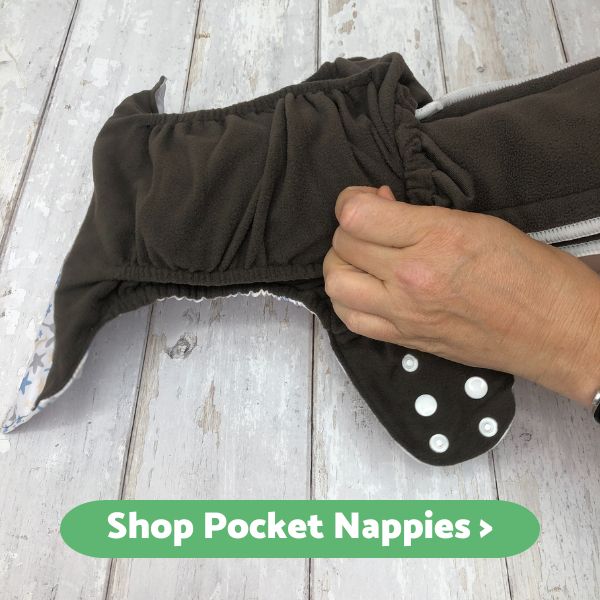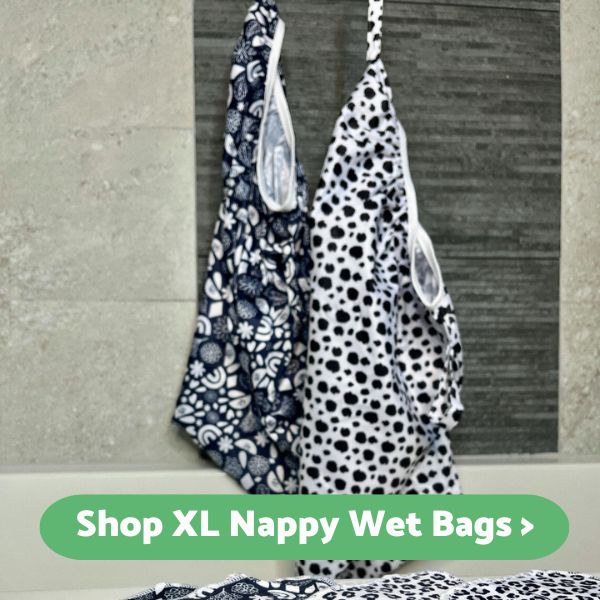How Do Reusable Nappies Work?
Using reusable nappies is becoming more and more popular, however, we get many questions from parents who are not sure how to begin. Whether they want to use reusable nappies full time or part time, they need help in getting started with reusables.
We have put together this guide answering some of your questions.
How Do Reusable Nappies Work?
Although they can appear confusing, reusable nappies work very simply. All reusable nappies are formed of 3 layers:
- stay dry liner against the skin
- absorbent layers to hold urine
- waterproof layer to prevent leaks
They're made from three fundamental layers, each playing a crucial role in their functionality: a stay dry liner, absorbent layers, and a waterproof outer layer.
Let's delve deeper to understand how modern cloth nappies work.
Stay Dry Liner
The stay dry liner is the first layer in contact with the baby's skin. This nappy liner is designed to keep the baby feeling dry by wicking moisture away from the skin. It's usually made of materials like microfleece or suede cloth, which have moisture-wicking properties. However disposable liners are also available.
By swiftly drawing moisture away from the skin, this layer helps prevent nappy rashes and discomfort, keeping the baby feeling comfortable and dry
On a pocket nappy, this is generally an integral part pf the nappy
Absorbent Layers
Situated beneath the stay dry liner are the absorbent layers. These layers are the workhorses of the nappy, responsible for soaking up pee.
They're typically made from natural fibers like cotton, hemp, or bamboo, known for their excellent absorbency. These materials can hold a significant amount of liquid, effectively trapping urine away from the baby's skin.
The number of absorbent layers and their thickness can vary among different brands or styles of reusable nappies, allowing you to tweak it based on a baby's needs.
You may find you need different absorbent layers or boosters for night time use for example.
Waterproof Layer
The final layer, the waterproof cover prevents leaks.
Usually made from a breathable yet waterproof material like PUL (polyurethane laminate) or TPU (thermoplastic polyurethane), this layer forms a barrier against any moisture absorbed by the nappy.
Despite its waterproof nature, this layer remains breathable, allowing airflow to prevent moisture buildup and maintain comfort for the baby.
"The new pocket nappies are soft and comfortable. Previously Charlie Banana was our favourite nappy brand but I think these might even beat them. Let's see how they wear after a few washes. Very pleased so far!" Trustpilot Review
How Nappy Layers Work Together
The functionality of reusable nappies lies in the synergy of these layers. When a baby pees, the stay dry liner swiftly wicks away the moisture from the skin, keeping the baby feeling dry.
The urine is absorbed by the layers beneath, preventing it from coming into contact with the baby's skin. The absorbent layers hold the liquid.
The waterproof outer layer acts as a barrier, ensuring that the pee doesn't leak out, thus keeping the baby and their clothing etc dry.
How to wash reusable nappies
Washing reusable nappies is easier than you think! Generally:
- Remove poo
- Put dirty nappies into a bucket or wet bag for storage until wash day
- Cold rinse cycle in washing machine
- Full wash
- Air dry where possible
To learn more about how to wash cloth nappies, read our nappy washing and care guidelines.
Advantages of Reusable Nappies
Understanding how these nappies work also sheds light on their advantages. Firstly, they're more environmentally friendly than disposable nappies. By opting for reusable nappies, families significantly reduce their contribution to landfill waste generated by disposable diapers as their baby grows.
Additionally, reusable nappies are cost-effective in the long run, as they can be popped in the washing machine and reused multiple times, saving money compared to continuously purchasing disposables.
Furthermore, reusable nappies often boast better breathability and fewer chemicals compared to some disposable options, potentially reducing the likelihood of skin irritations or allergic reactions in babies. They also come in a variety of designs and styles, offering parents flexibility and choice in finding the best fit for their baby.
"Dear Cheeky Wipes, after making the wonderful transition from disposable wipes to cheeky wipes I was keen to transition to cloth nappies. I was so ashamed of how much waste we were creating with disposable nappies. I researched for months and after having such a great experience with your cheeky wipes I knew I could trust your cloth nappies. I ordered your cloth nappies to use as a night time nappy for my daughter and we have been using them for 7 months. My daughter is petite and we have been using the size 2 nappies since she was approx 7kg and they have been perfect for her. She is a bit of a heavy wetter and so we just experimented with different boosters until we found a suitable combination (it currently is hemp, bamboo and then microfibre). thank you :)" Trustpilot Review
How do you know when a cloth nappy is wet?
It can be quite tricky to tell when a cloth nappy is wet, without touching it or sniffing it because generally they are white in colour which doesn't show wetness!
However Cheeky Doodoo nappies are grey in colour which means wet nappies are easy to spot.
In conclusion, the seemingly complex nature of reusable nappies boils down to a simple yet efficient combination of layers designed to keep babies dry, comfortable, and leak-free.
That brings us to the end of our blog, we really hope the above has given you an insight into using reusable nappies. You can browse our full range of nappies here. Of course if you do have any other questions you can get in touch and a member of our team will be happy to help.
About the Author: Helen Rankin founded Cheeky Wipes, the original reusable wipes kit back in 2008 after disposable wipes caused her eczema to flare up. 4 kids later, internal period protection such as tampons or menstrual cups were no longer an option for her and she went on to develop their range of 'Simple Reusables' to include period pants, reusable panty liners and reusable sanitary pads.
The Cheeky customer services team pride themselves on providing honest, friendly advice and just LOVE to chat pee, poo and periods all day long, helping people make the switch to reusables! The Company was recognised for their hard work in developing environmentally friendly products with the Queens Award in Enterprise for Sustainable Development in 2021.

